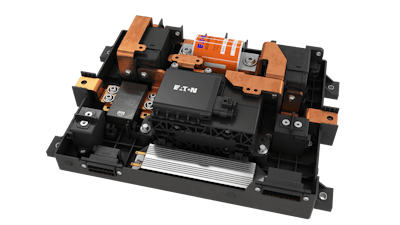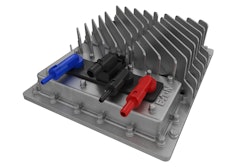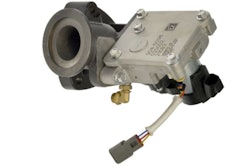
Eaton announced Tuesday its eMobility business has introduced a battery disconnect unit (BDU) that can be combined with upgraded Breaktor circuit protection technology to provide circuit protection in electrified vehicles (EVs) while reducing overall complexity and cost.
When paired with the Breaktor circuit protection technology, which combines current switching and resettable bidirectional short-circuit protection with fast actuation, Eaton says its BDU eliminates the need for up to 15 additional system components. Traditional systems require a combination of pyro and thermal fuses and contactors.
[RELATED: Volvo rolls out latest VNR Electric and an autonomous diesel VNL]
“As manufacturers continue to increase the power levels in EVs, it’s increasingly important to have capable and dependable protection solutions,” says Kevin Calzada, global product strategy manager, Eaton’s eMobility business. “Our BDU combined with our Breaktor circuit protection technology provides everything needed, in a compact and efficient package, to protect the vehicle and occupants.”
According to Eaton, the BDU’s primary function is to serve as an on/off switch to the battery depending on the mode the EV is operating in, such as charging or driving. Current model EVs rely on one of three traditional BDU configurations: fuse and contactor; pyro fuse and contactor; or fuse, pyro fuse and contactor, all used together in a single BDU. While all provide switching and protection functions, they each have disadvantages, including overall system complexity, serviceability, coordination difficulties and susceptibility to fatigue under high current levels.
Adding Breaktor circuit protection technology to Eaton’s BDU provides extra functionality and benefits, the company states, including active and passive actuation in a single device; the capability to transition to an off-state under a wide range of fault conditions; improved functional safety; the ability to be reset after a high-energy fault; and the ability to replace up to four high-voltage electrical components, which reduces complexity and system-level cost.
“Our Breaktor circuit protection technology’s self-triggering design, diagnostic electronics and mirror contact help achieve BDU functional safety goals,” Calzada says. “With its integrated coil driver, economizer, and the sensing/triggering circuit, Breaktor circuit protection technology also reduces battery management-system cost and complexity.”
[RELATED: Freightliner unveils new electric eCascadia]
Eaton’s Breaktor circuit protection technology also enables up to 350 kW DC fast charging when used to protect and switch the DC fast-charge circuit, allowing EVs to charge in 15 minutes or less. The company says this capability is made possible by recent upgrades to the Breaktor circuit protection technology’s thermal management and materials to boost its power capacity. Breaktor circuit protection technology is now able to carry 500 amps continuously and up to 750 amps of continuous current when an active or passive cooling system is leveraged.
“Breaktor achieves best-in-class current ratings, and these can be even further increased with an appropriate cooling strategy,” Calzada adds. “Eaton is able to design and develop a compatible cooling system to customer specifications and integrated into a BDU to meet these rising power requirements.”










